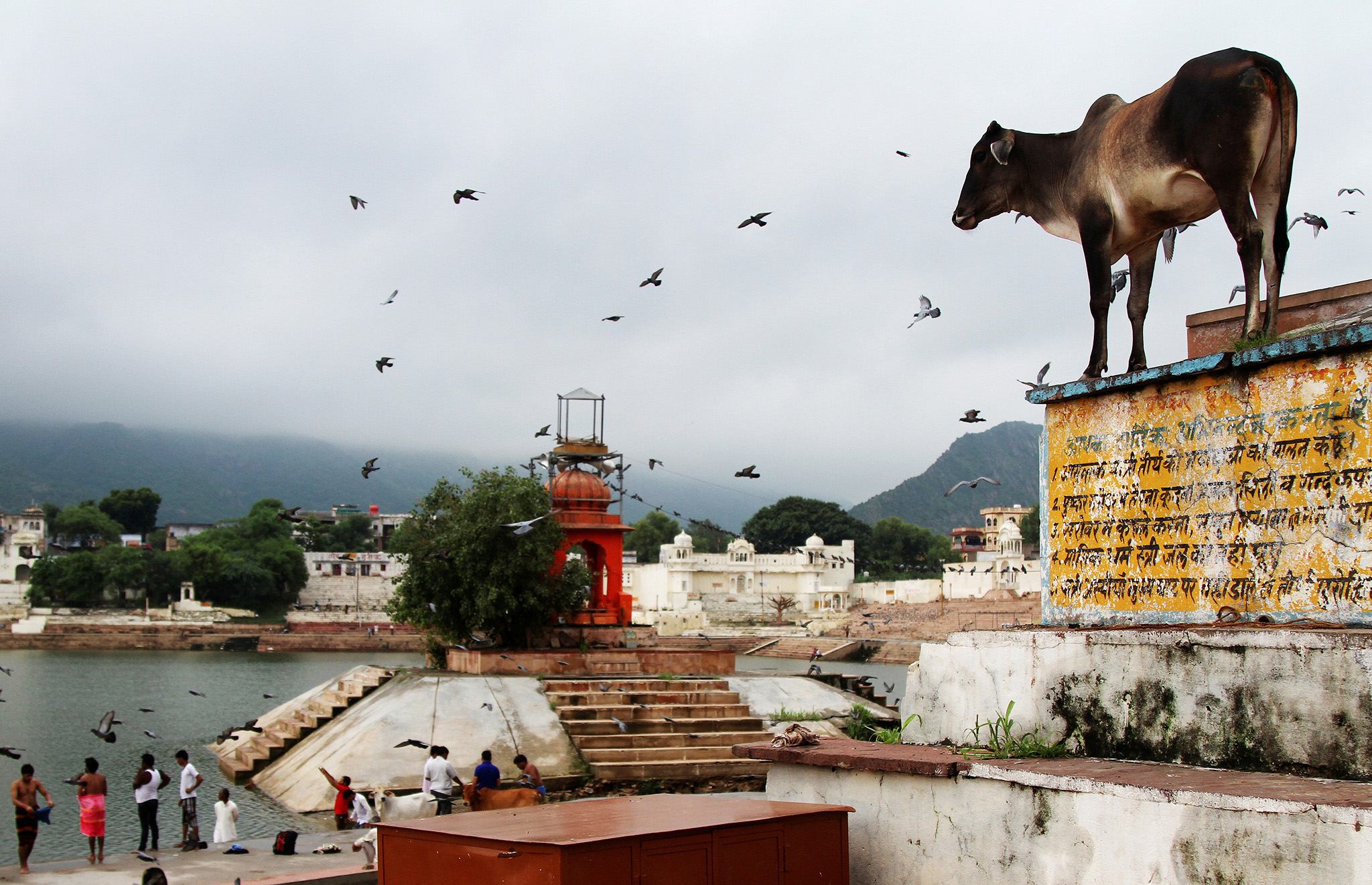.

A cow on the outskirts of Srinagar chews on a copy of a newspaper showing images from the 26th day of protests against Indian occupation in Kashmir: photo by Danish Ismail / Reuters, 5 August 2016
A cow stands outside a temple at a lake in Pushkar, in the desert state of Rajasthan, India: photo by Himanshu Sharma/Reuters, 5 August 2016
A cow stands outside a temple at a lake in Pushkar, in the desert state of Rajasthan, India: photo by Himanshu Sharma/Reuters, 5 August 2016
Burhan's Down Town: The Making of Popular Hero In Absentia

A woman walks down a deserted street in old Srinagar on a day of shutdown and protests: photo by Faisal Khan via Kashmir Reader, 5 August 2016
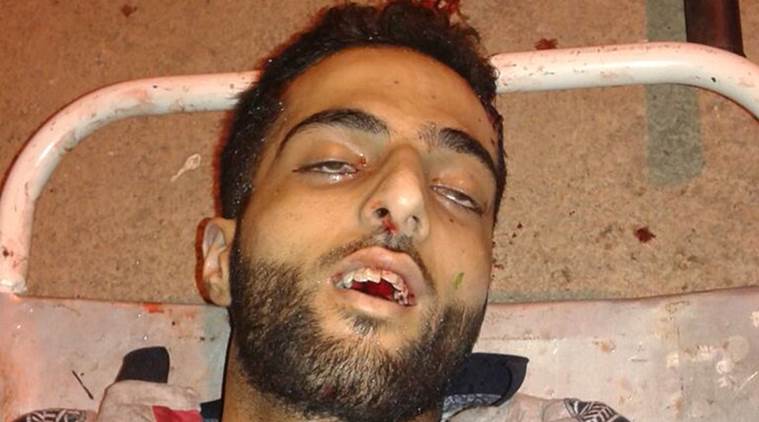
Burhan Wani joined the Hizbul Mujahideen in 2010, when he was just 15 years of age: image via the Indian Express/ANI, 8 July 2016
Hizbul Mujahideen ‘poster boy’ BurhanWani killed in joint encounter: Burhan Wani was cornered in Bumdoora village of Kokernag today morning by a joint team of police and Army: The Indian Express, 8 July 2016
Top Hizbul Mujahideen commander Burhan Muzaffar Wani was among the three militants killed by security forces in Anantnag, Jammu-Kashmir on Friday.
Jammu and Kashmir police chief K Rajendra confirmed that Burhan was killed in an exchange of fire between security personnel and militants. He was cornered in Bumdoora village of Kokernag today morning by a joint team of police and Army. Among those killed, one was identified as Sartaj Ahmed Sheikh and another is yet to be ascertained.
Meanwhile, Separatist leaders Syed Ali Shah Geelani and Asiya Andrabi gave a call for complete shutdown in Jammu and Kashmir tomorrow to protest against Burhan’s killing.
Burhan joined the militant outfit in 2010, when he was just 15 years of age. He was considered as the ‘poster boy’ of the Hizbul Mujahideen.
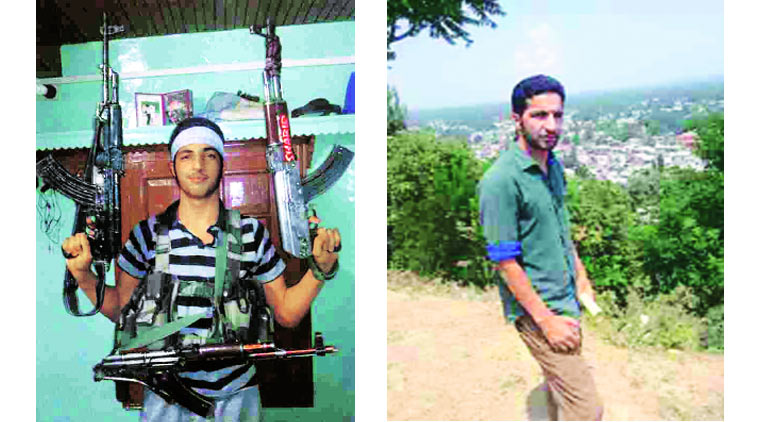
Burhan (left) had joined Hizbul Mujahideen in 2010, and elder brother Khalid was far removed from him, says family: image via the Indian Express/ANI, 8 July 2016
Burhan was among the new wave of tech-savvy militants who used to leverage social media to recruit and influence Kashmiri youth. His family currently lives in Tral. Burhan’s elder brother Khalid was also shot dead by the Army last year. Burhan carried a cash reward of Rs 10 lakh on his head.
Last month, the 21-year-old commander Burhan released a video warning of attacks on separate colonies for Sainiks and Kashmiri Pandits if they are set up in the Valley. The major part of the video message, however, was directed at the Jammu and Kashmir Police warning them of more attacks.
The Restored Humanity of Commander Burhan Wani

Hey Cartoon Network @narendramodi See this This is Srinagar IOK where #GoGreenIsGoingStrong and amazing: image via Bhaija Fry @Bhaija Fry, 4 August 2016

Sikh community shows full support to Kashmir freedom movement and pays regards to #Burhan #FreeKashmirAndKhalistan: image via Bhaija Fry @Bhaija Fry, 4 August 2016
The Restored Humanity of Commander Burhan Wani: Mohamad Junaid, Raiot/Kashmir Reader, 14 July 2016
On Friday evening, the news of Burhan Wani’s killing arrived in my phone with a picture of his dead body. The picture was gruesome, taken from an angle meant to amplify its gruesomeness. Given the way Kashmiri rebels have been depicted in the visual culture of the Indian military occupation, I didn’t expect Burhan’s killers to show respect for his body. For years, police and military photographers have circulated pictures of dead Kashmiri militants that show them disheveled and bloodied, with torn clothes and limbs out of joint, presenting the figure of the Kashmiri rebel as a wild, hunted felon. The intent has been clear: criminalize their thoughts and bodies, and show them as existing beyond the pale of society and humanity. It is easier to kill that way, easier than what the occupation has already made possible.But Burhan had created his own visual counterculture. In image after image, and video after video, the young commander was seen not as a figure on the run, but one who seemed to truly enjoy his life among his comrades. In contrast to the violence depicted in the images circulated by the state, and the captions that accompanied them, Burhan’s images were tranquil and content. There was never a hint of violence in those images, despite the weapons that always remained in the background -- those weapons would appear to be arranged as proud signs of defiance rather than as crude instruments of violence. The dramatic co-existed with the mundane. In one video, he is playing cricket with grenades strapped across his body juggling clangorously. His enthusiastic comrades, with similar gear, are running after the ball. How risky, I thought when I saw it; yet I could not shake the feeling that his joie de vivre was infectious. His other pictures, where he is standing, again with weapons, against the backdrop of Kashmir’s snowy mountains and verdant hills, seem to express a sense of belonging to Kashmir as a place as it is popularly imagined. People who saw those pictures wished him safety. “Khuday karnei raechh (May Khuda protect you),” they would say. If the obscenity of the images circulated by the state repulsed people, Burhan’s images evoked a tender affection.
It was not the military logic of ‘recruitment’ that undergirded Burhan’s pictures (as the ‘poster boy’ theorists would have us believe); neither do I think he intended to create a new visual counterculture of the rebellious Kashmiri youth. The images simply reclaimed the humanity of the ‘Kashmiri militant', and reconnected the idea of the rebel with his people at the visceral level. His images also acquired a symbolic logic over time: To exist as a joyous rebel undermined the entire story the Indian state tells its citizens and Kashmiris. If the “new militancy” was anything, then, it was the emergence of the exuberant new movement driven by spontaneous solidarities, and the collective expression of popular sentiment against the forces of occupation.
Indeed, there might be truth to the claim many sober Indian writers have made that Burhan and his family suffered personal violence, which drove him to pick up weapons. Yet, such claims are often accompanied by efforts to present Burhan as an impressionable youngster. If the state had been nice, it is said, Burhan might have become something else -- preferably a bureaucrat, an aspirational slot fixed for the ‘good Kashmiri’ in the Indian nationalist fantasy. Yet, all of this denies Burhan his political maturity, and his understanding of the Kashmir situation. In his videos, there is a remarkable absence of personal resentment. Nor does he seem to express any anxiety about his imminent death (which, of course, made many in Kashmir worry about him more).
Most analysis of the post-Burhan moment, so far -- even the one that claims to counter the cruder aspects of the state propaganda -- tends to fall within the acceptable prism of the state discourse. Appeals such as “state be nice,” “talk to them,” or “exercise calm,” despite good intentions, appear too naïve compared to how ordinary Kashmiris see the nature of the Indian rule in Kashmir. The same opinion tends to patronize Kashmiri youth, asks state officials to talk to their parents, and advises youth to protest -- if they have to -- “as they do at Jantar Mantar.”
Kashmiris know the occupation is chronically violent, persistently vindictive, and is going to remain so as long as it exists. The state that denies a people their right to self-determination can be nothing but repressive. How could Burhan not have shared the same understanding of the Indian control over Kashmir? Is it misplaced to think so? And is it then an accident that Burhan became Commander Burhan Wani? Or is it immanent to a condition of injustice that rebels such as Burhan emerge or the methods they choose?
In the history of political struggles, some individuals become indices of their times. They gather the dispersed fragments of the social order and disorder in their words or being, and, as such, come to represent an event in themselves. The figure of Burhan Wani, similarly, represents a new moment in the political history of the Tehreek movement. Maqbool Bhat, it is true, was not so well known until he was executed by the Indian state in 1984. It was a time of elite political intrigue amid a general culture of desperate silence. Bhat became a lightning rod of political clarity against that silence, a shattering rupture in the dominant discourse. Ishfaq Wani, the rebel commander of the 1990 movement, concretized that rupture, embodying the mass rebellion against the order established in 1947. Even Afzal Guru became an index of the Kashmiri otherness in the Indian ethical imagination -- an impossibility of justice under the punitive occupation. Burhan Wani gathers in his being this entire political history. But, more importantly, through his images, he brought the rebellion out of the shadows to which the occupation had successfully driven it. He represents the restored humanity of the Kashmiri rebel, the decriminalization of the idea of Azadi in Kashmir, and, foremost, the idea of joyous rebellion against the repressive domination.
Open Letter by Burhan Wani to Major Arya
Burhan Wani (d. July 2016): photo via Countercurrents, 4 August 2016
Open Letter by Burhan Wani to Major Arya: Mohd Azhardin Ganayee, CounterCurrents, 4 August 2016
ToMajor Arya (Veteran)
Indian Army
Indian Army
Hello,
I hope you are in good spirits. I will take the liberty of addressing you as my friend. I know that you consider me as a lowly terrorist but now that I am dead, the animosity can take a backseat; at least for the course of this letter. My friend, I am told that you have written an open letter to me. I thank you for making the effort to reach out to me even though it might be a little late. Better late than never.
Indeed I knew the result of taking up the gun against the Indian state. Don’t for a moment think that I was led astray by someone or that I was stupid to think otherwise. It is no easy decision to take a path where the end is death. I understand this surprises many people. I didn’t choose this path out of hatred of your country or religion. I know a lot of your countrymen tend to think like that. It was not the case with me though.
Major Arya, my friend, I was born in a place where love, hospitality, pluralism, and communal amity have been integral to life since times immemorial. How I wish life would have allowed me to host you some day. Had you been to Tral on the day of my funeral, you would have seen Sikh brothers weeping alongside their Muslim brethren. You would have seen them serving food to the mourners and marchers. My friend I always maintained that Amarnath Yatris are welcome here. I had also assured our Pandit brothers of protection, should they decide to return back to their villages. True, my friend, I had vowed to fight the plan for separate colonies. These colonies would have turned into cause of mutual acrimony and discord instead of reconciliation.
You might be wondering what, if not hatred, prompted me to choose this path. One of the most frightening memories of my childhood is the “crackdown”. You would know why if you have served in Kashmir. Succinctly, I remember elders being humiliated, the youth being beaten, the womenfolk being jeered at and the children being threatened. This was a regular feature of my childhood days. My friend, can you imagine how you would feel if you have to prove your identity every day in your own home and neighbourhood to people from a different culture, region and language. I had friends in school whose fathers had been killed. Some in real encounters others extra judicially. This was my childhood. That is how I grew up.
My agitated mind asked questions. I started asking whoever I could for the reasons behind all this. I began reading whatever I could regarding the Kashmir issue. Then I came to know there is an escape from this misery. People call it Azadi. I understand, my friend, that you love your country. You are ready to do anything for its sovereignty and integrity. But I didn’t see my dream of Azadi as a vengeance against your country. I just saw it as a basic human right of my people to live a life of respect and dignity. If the integrity or sovereignty of any country is devoid of this I was willing to challenge it. I knew the cost of doing so but I made my decision.
As I reached higher grades in school I began reading more about the history of the Kashmir issue. I wish you would have done the same before you wrote to me. I came to know that Kashmir had acceded to India subject to ascertaining the wishes of the people. Your first PM had promised the plebiscite on the floor of your parliament. He had also promised it at the UN and also in the LalChowk of Srinagar. The promise awaits fulfilment. I read about the gang rape of an entire village at Kunanposhpora, Kupwara by the Rajputana rifles of your Army. I read about the massacres of Gawkadal, Sopore, Handwara, Bijbehara, so on and so forth. My friend the list is long. I hope you take some time to read about some of this. Do you know my friend that around ten thousand people have vanished in custody? You might not know this. You might not even want to believe this. But how can we disbelieve what we have suffered?
My friend, you might argue that I could have chosen other ways of struggle. I did try but it was not to be. In 2008 I participated in massive peaceful protests. I was there in Eidgah rally when over a million people marched peacefully. Not a glass was broken that day. But the government could not bear the open show of defiance. It responded with curfews and unprovoked firing of protesters. Boys responded with stones. You might know that in the protests of 2008 and 2010 hundreds of young boys were butchered on the streets of Kashmir for pelting stones or marching. Many of my friends lost their lives or limbs. This battle of bullets and stones left a deep imprint on my mind. For the first time I began thinking of picking up the gun. But I wasn’t sure yet.The last straw came in 2010 when I and my elder brother were beaten to pulp by the “security forces” without any reason. I could not bear seeing my elder brother being beaten in front of me. That was the day when I escaped to the forests and became a militant.
The people here called me a Mujahid i.e. a righteous warrior. You call me a terrorist. But, my friend, I have never harmed or even threatened any civilian. My struggle was not driven by hatred. How would you have responded had you been born here in my place? You could have chosen to build a career while keeping aloof from the system. Or you could have tried to change the system from within. Or you might have tried to challenge it by peaceful means. Or you could have joined my group. All these are different forms of resistance. There is another possibility. You could have become a collaborator to the system. But I am sure a conscientious and intelligent person like you wouldn’t have chosen this ignominious option.
My friend, I chose a way of resistance which I knew will lead to death. I have no regrets. Neither do I have any complaints from you or your people. All that I am asking you is to ask yourself why would 3 lac people participate in my funeral if I was a terrorist? Why would the whole valley mourn me if I was a nihilist? My friend, Major Arya, I and my people harbour no ill will towards your people and country. All that we want is basic rights of self-determination, life, security, and dignity. I wish Kashmir and India have a wonderful relationship based on love and respect instead of bloodshed and hatred. But that will not happen unless and until you see reason.
Regards,
Commander Burhan Wani,
Martyrs Graveyard,
Tral, Kashmir
Martyrs Graveyard,
Tral, Kashmir

#Kashmir #KashmirKillings #TweetLikeIndianMedia: image via Khan Furaat @khanfuraat, 4 August 2016

People attending funeral of terrorist. 5 to 10 close relatives attending funeral #TweetLikeIndianMedia: image via #Kashmiris @Kashmiris, 4 August 2016
#India outraged as pellet guns injure 4 cows in #Kashmir #Satire #TweetLikeIndianMedia: tweet via Syed Ali Geelani @sageelani, 6 August 2016
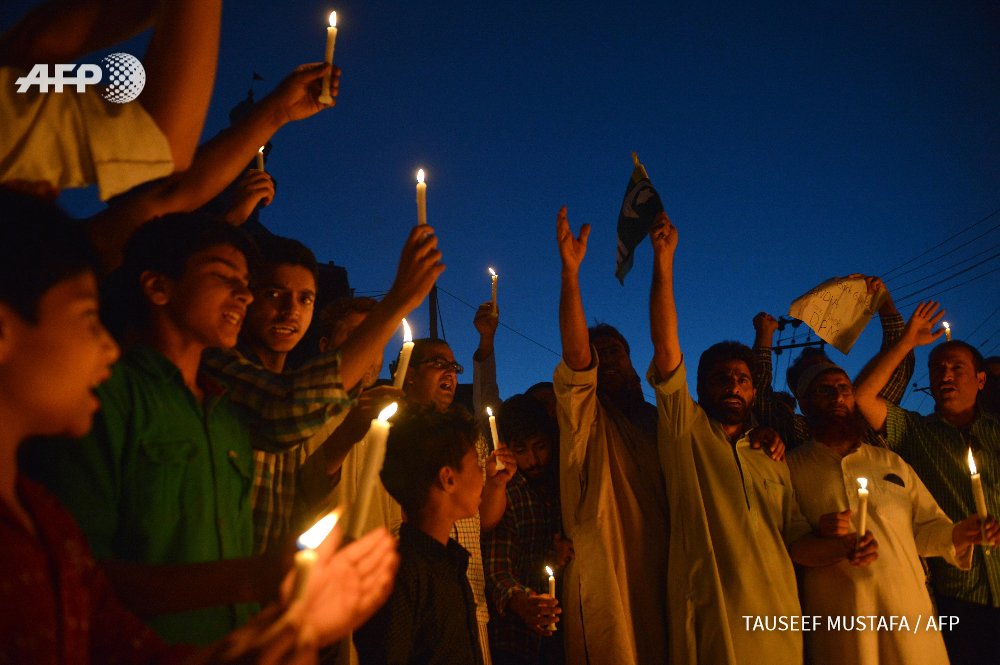
INDIA - Protest against the killing of civilians in Kashmir's ongoing summer unrest in Srinagar. By @TauseefMUSTAFA: image via Frédérique Geffard @fgeffardAFP, 5 August 2016

Candle Light Protest At Safa Kadal #Kashmir via @AwaazKashmir: image via Syed Ali Geelani @sageelani, 5 August 2016

Protesters run away as a policeman fires tear gas towards them during a protest against the recent killings in Kashmir, on the outskirts of Srinagar, August 5, 2016. photo by Reuters/Danish Ismail/Reuters, 5 August 2016; image via Reuters Top News @Reuters, 6 August 2016
Indian forces kill three in Kashmir as fresh protests erupt: Fayaz Bukhari, Reuters, 5 August 2016
SRINAGAR - Indian security forces opened fire on curfew-defying protesters in the disputed region of Kashmir on Friday, killing three and bringing the number of people killed in a wave of unrest to 55.The recent protests erupted in July over the killing of Burhan Wani, 22, a commander of the Hizbul Mujahideen militant group, a separatist group.
In Friday's shootings, two protesters were killed in the west of Srinagar, Jammu and Kashmir state's summer capital, and one in the north of the city after crowds began attacking police and paramilitary positions following Friday prayers, a senior police officer said.
More than 100 people were wounded including several police officers, the police officer said, speaking on the condition he was not named because he was not authorized to speak to the media.
India has urged its security forces to act with restraint as they try to keep protesters off the streets and quell near-daily violence that has flared since July 9, but some have accused troops of using excessive force to control the protests.
The Muslim-majority region of Kashmir has been divided between Pakistan and India since shortly after the two countries were carved out of Britain in 1947. Both claim the territory as theirs in full and they have fought two of their three wars over the region.
The weeks-long unrest has further strained relations between the two countries and this week threatened to overshadow a regional forum meeting in Islamabad that was attended by India's interior minister.
India accuses Pakistan of smuggling fighters across its border to attack forces in the Indian-administered portion of the region, a charge Islamabad strongly denies.
Militant attacks against Indian forces have fallen substantially from a peak in the 1990s, but the Indian state has failed to tackle widespread resentment against its rule and there remains a simmering insurgency.
Prime Minister Narendra Modi's government has vowed to continue hunting militants while increasing aid and development for the region.
In Friday's shootings, two protesters were killed in the west of Srinagar, Jammu and Kashmir state's summer capital, and one in the north of the city after crowds began attacking police and paramilitary positions following Friday prayers, a senior police officer said.
More than 100 people were wounded including several police officers, the police officer said, speaking on the condition he was not named because he was not authorized to speak to the media.
India has urged its security forces to act with restraint as they try to keep protesters off the streets and quell near-daily violence that has flared since July 9, but some have accused troops of using excessive force to control the protests.
The Muslim-majority region of Kashmir has been divided between Pakistan and India since shortly after the two countries were carved out of Britain in 1947. Both claim the territory as theirs in full and they have fought two of their three wars over the region.
The weeks-long unrest has further strained relations between the two countries and this week threatened to overshadow a regional forum meeting in Islamabad that was attended by India's interior minister.
India accuses Pakistan of smuggling fighters across its border to attack forces in the Indian-administered portion of the region, a charge Islamabad strongly denies.
Militant attacks against Indian forces have fallen substantially from a peak in the 1990s, but the Indian state has failed to tackle widespread resentment against its rule and there remains a simmering insurgency.
Prime Minister Narendra Modi's government has vowed to continue hunting militants while increasing aid and development for the region.
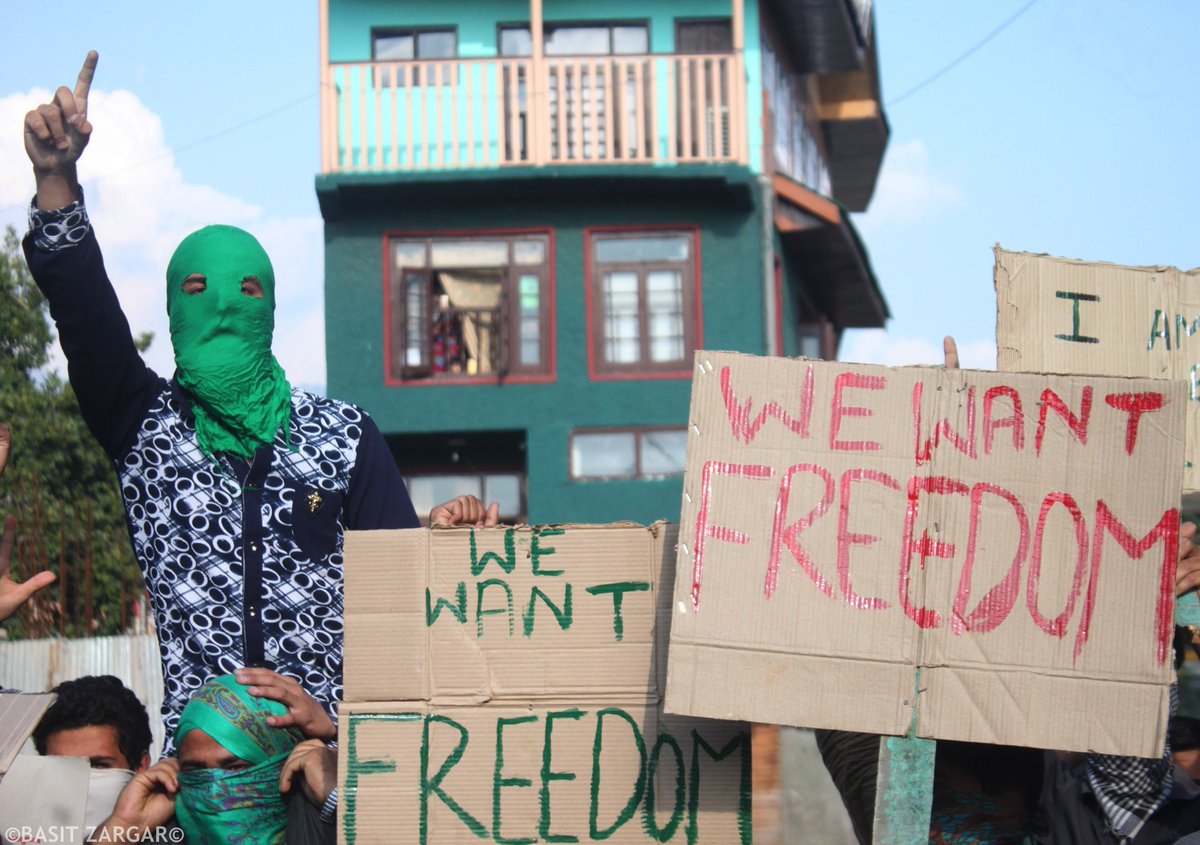
A masked Kashmiri Muslim boy shouts pro freedom slogans during a protest in Srinagar. image via BASIT ZARGAR @BASIIVJ, 5 August 2016
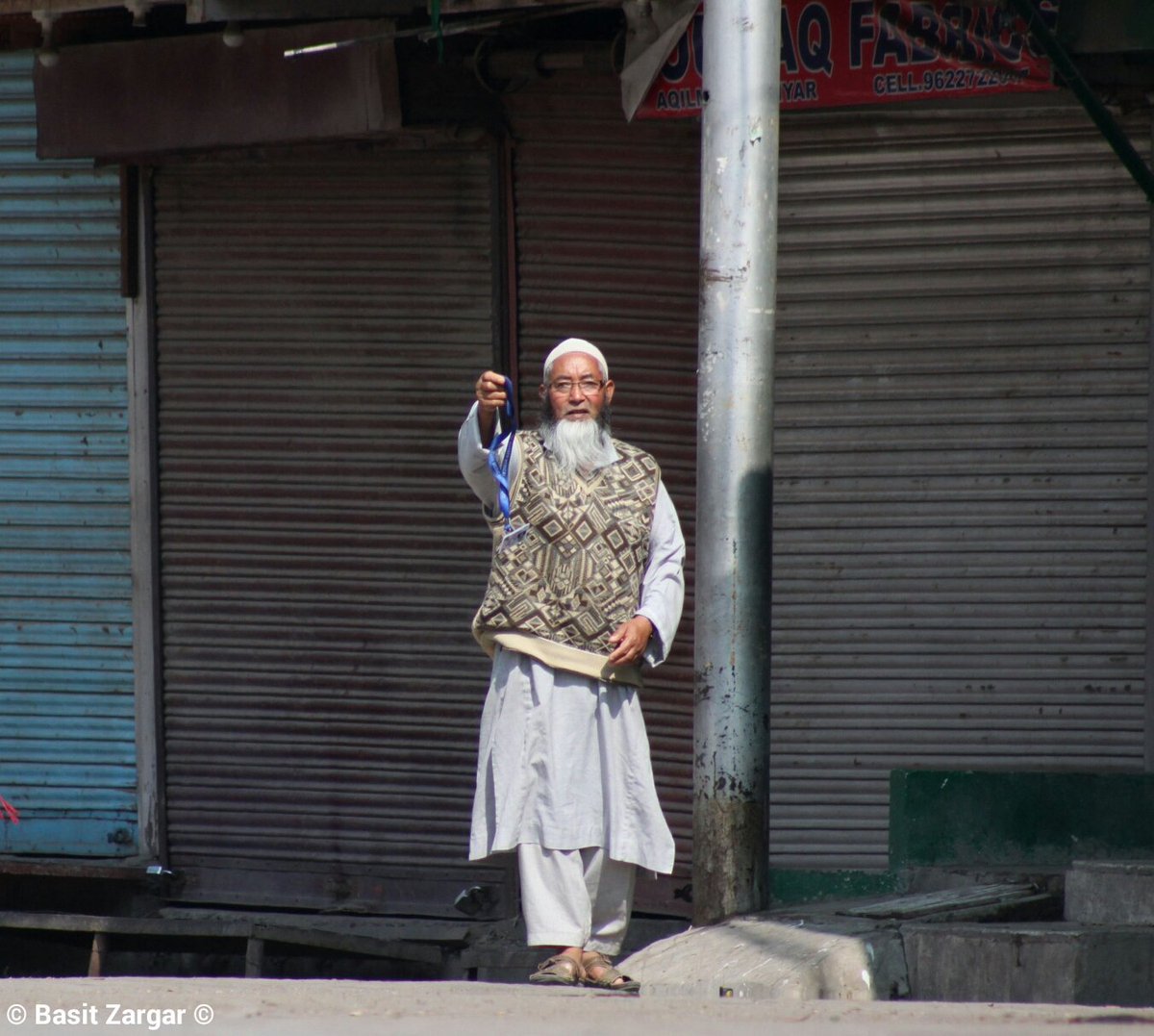
An Elderly man shows his Identity card during a curfew in Srinagar on 28th day: image via BASIT ZARGAR @BASIIVJ, 4 August 2016

Clashes between protestors and Occupation forces today after Friday prayers in #Kashmir's Prichoo, Pulwana: image via Kashmir Dispatch @Kashmir Dispatch, 5 August 2016
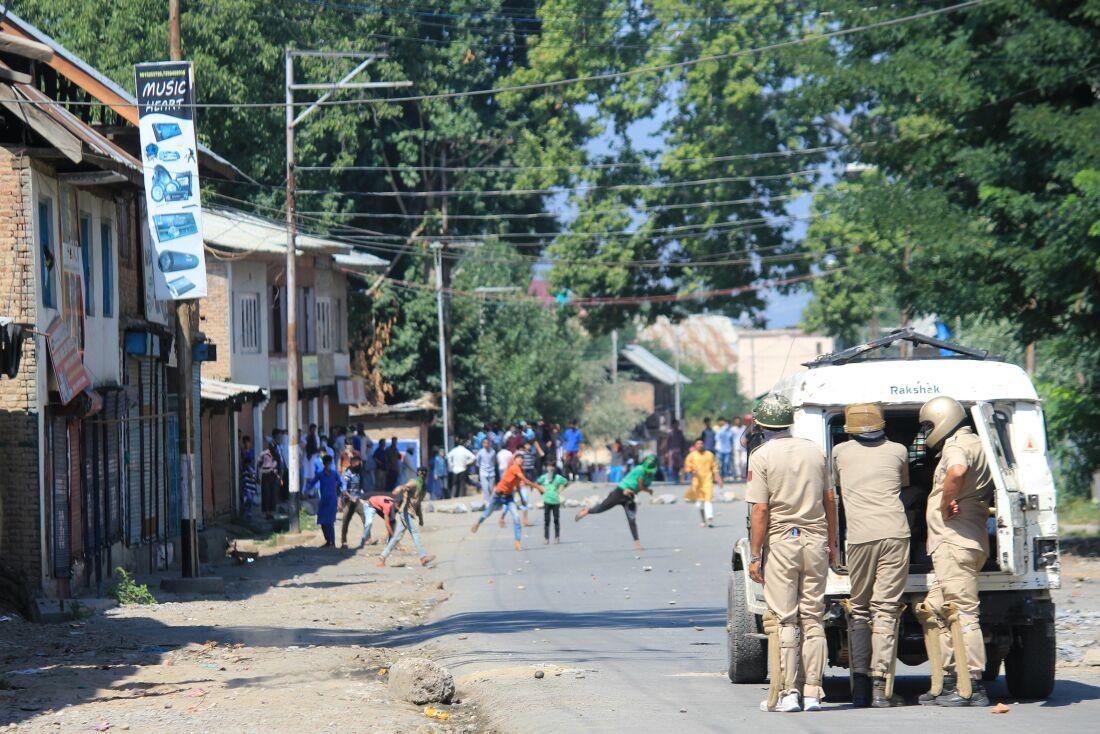
Clashes between protestors and Occupation forces today after Friday prayers in #Kashmir's Prichoo, Pulwana: image via Kashmir Dispatch @Kashmir Dispatch, 5 August 2016
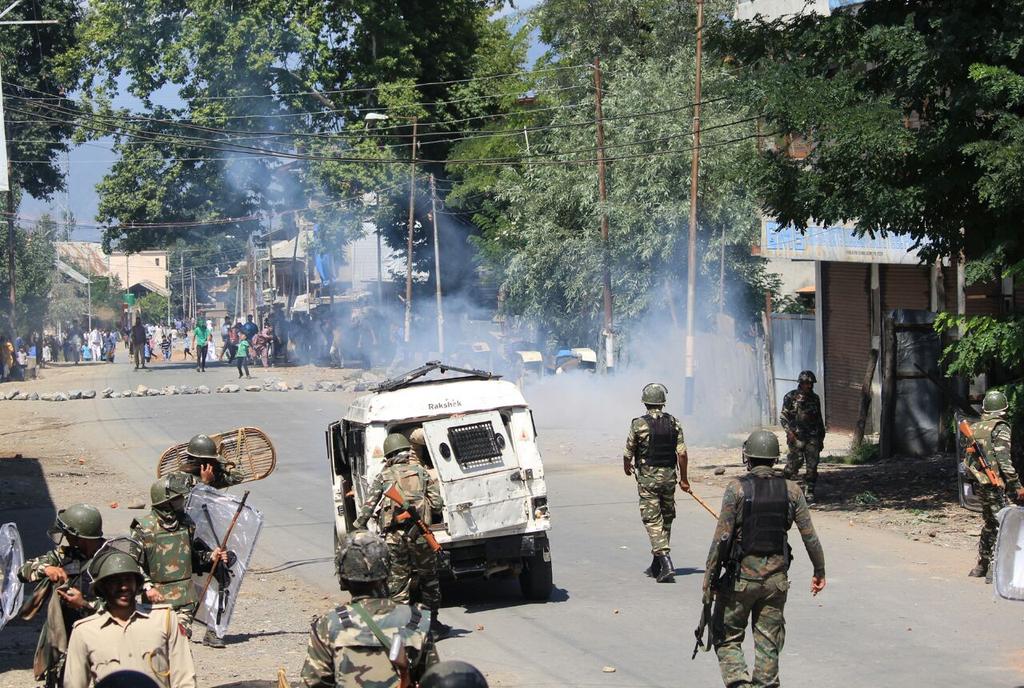
Clashes between protestors and Occupation forces today after Friday prayers in #Kashmir's Prichoo, Pulwana: image via Kashmir Dispatch @Kashmir Dispatch, 5 August 2016

Post-friday-prayer protests in Doda against Indian occupation of #Kashmir: image via Syed Ali Geelani @sageelani, 5 August 2016

Post-friday-prayer protests in Doda against Indian occupation of #Kashmir: image via Syed Ali Geelani @sageelani, 5 August 2016

Protest Rally @Baramulla Town: image via MOHAMMAD JAVAID @MOHAMMAD_ JAVAID9, 5 August 2016
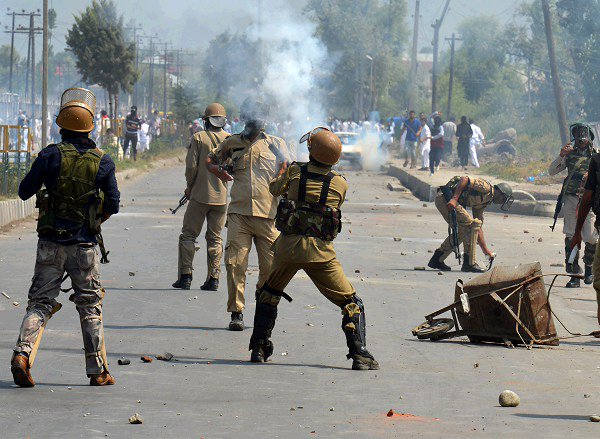
Advisor on Foreign Affairs highlights state of medical emergency in Occupied #Kashmir: image via Radio Pakistan @Radio Pakistan, 5 August 2016

3 more have been Martyred by Indian forces today during the anti-occupation protests in Kashmir. Death toll 64.: image via Syed Ali Geelani @sageelani, 5 August 2016

A 20-yr-old youth of Beerwah area of Budgam district was brought dead to SMHS hospital on Friday afternoon: image via Syed Ali Geelani @sageelani, 5 August 2016

#Kashmir People Offering Nimaz jenaza of Martyred Youth Zahoor from #Beerwah Outside SMHS hospital Srinagar: image via Syed Ali Geelani @sageelani, 5 August 2016

Special prayers at Alamgari Bazar via @__qureshi in Srinagar. Funeral prayer in absentia was also held. #Kashmir: image via faysal @_Faysal, 5 August 2016
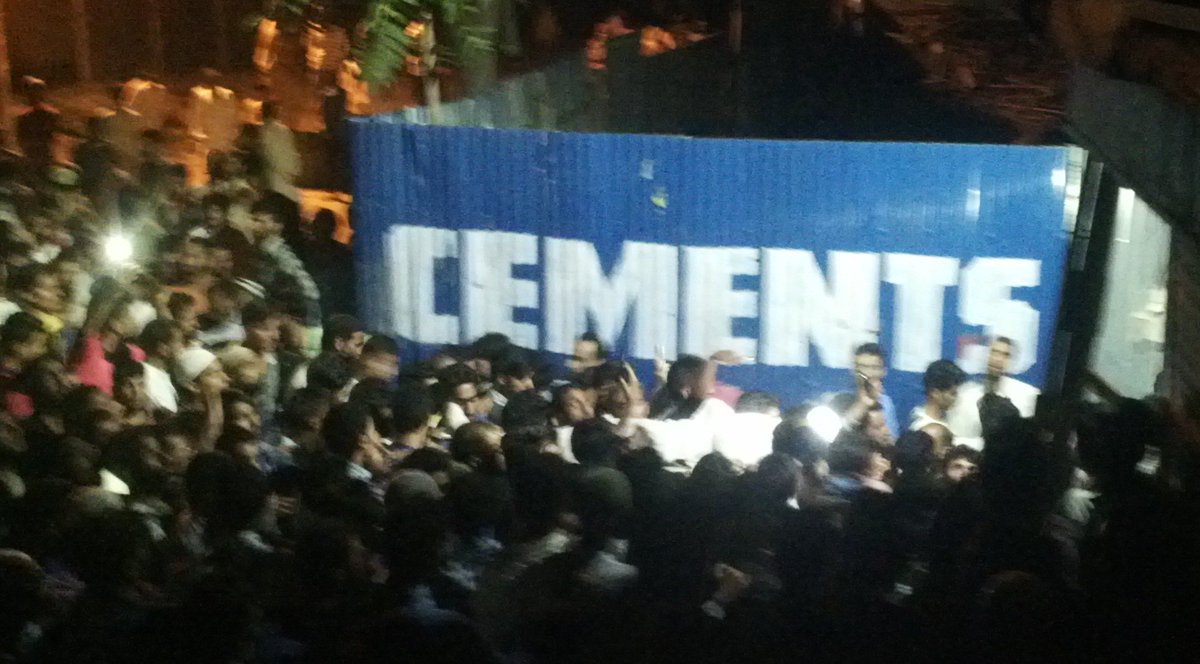
Funeral procession of martyred Sopore youth Danish Kana on its way to 'Charai ground'. #KashmirKillings #Kashmir: image via Shahid Wani @CounterTweet, 5 August 2016
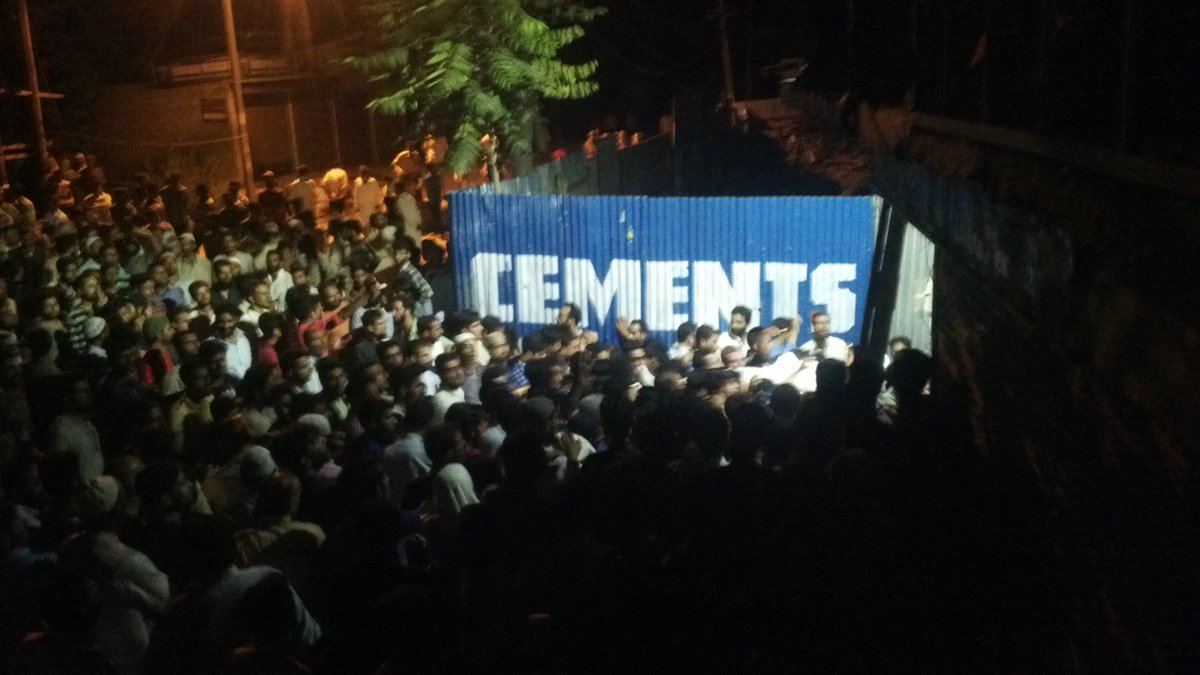
Funeral procession of martyred Sopore youth Danish Kana on its way to 'Charai ground'. #KashmirKillings #Kashmir: image via Shahid Wani @CounterTweet, 5 August 2016

[in Sopore]: image via Syed Ali Geelani @sageelani, 5 August 2016

[in Sopore]: image via Syed Ali Geelani @sageelani, 5 August 2016

[in Sopore]: image via Syed Ali Geelani @sageelani, 5 August 2016

[in Sopore]: image via Syed Ali Geelani @sageelani, 5 August 2016
Day 27: Burhan's Down Town

Children participate in a march held at Barzulla, Srinagar: photo by Faisal Khan via Kashmir Reader, 5 August 2016

Legislator Engineer Rashid being detained at Srinagar: photo by Faisal Khan via Kashmir Reader 5 August 2016

People stage a pro-freedom rally at Anchidora, Anantnag: photo by Muneeb Gul via Kashmir Reader, 5 August 2016

Residents of Kanli Bagh, Baramulla offer prayers on the main road: photo by Nisar Malik via Kashmir Reader, 5 August 2016

Asar prayers being offered on the street at Sopore: photo by Eeshan Peer via Kashmir Reader, 5 August 2016

Prayers offered on a street at Rawalpora, Srinagar: photo by Muzamil Mattoo via Kashmir Reader, 5 August 2016

People offer Magrib prayers at Nai Basti, Anantnag: photo via Kashmir Reader, 5 August 2016

Youth protest at Arampora, Kupwara: photo by Nisar Malik via Kashmir Reader, 5 August 2016

Masked youth stage a protest in uptown Srinagar: photo by Muzamil Mattoo via Kashmir Reader, 5 August 2016

People wait for their turn outside an ATM in Srinagar: photo by Muzamil Mattoo via Kashmir Reader, 5 August 2016

A Mahjoor Nagar, Srinagar, family tries to save window panes of its house with blankets: photo by Muzamil Mattoo via Kashmir Reader, 5 August 2016
Day 28: Dargah chalo foiled

Sopore residents protest killing of a local youth by government forces
Curfew Extended in Kashmir, but 2 Die, Many Hurt in Clashes: The Associated Press, 5 August 2016
SRINAGAR, India — Authorities in Indian-controlled Kashmir extended a curfew to most of the disputed Himalayan region Friday in an attempt to prevent an anti-India protest march to a prominent shrine, but clashes erupted as thousands defied the restrictions.
The mostly Muslim region, where resistance to rule by predominantly Hindu India is strong, has been under a rolling curfew and strikes for nearly a month after the killing of a popular rebel commander sparked massive anti-India demonstrations. At least 54 civilians and a policeman have been killed and thousands injured.
Separatists called Kashmiris to march to Hazratbal shrine in the city of Srinagar and stage protests after Friday prayers there.
Police and paramilitary soldiers patrolled streets and laid razor wire and steel barricades to cut off neighborhoods in the city. Shops, businesses and schools remained closed for the 28th consecutive day.
Thousands of Kashmiris defied the security lockdown and demonstrated at dozens of places in the region. They chanted slogans such as "Go India, go back" and "We want freedom."
Violence erupted in at least two dozen places after government forces intercepted the protesters and fired live ammunition, tear gas and shotgun pellets, police and witnesses said.
Two men were killed and at least 100 civilians were injured, some of them critically. At least 20 police and soldiers were also reported injured.
Troops continued firing shotguns to disperse angry crowds despite warnings from India's home ministry to minimize their use, and requests for a ban from local and international rights groups. The pellets have killed at least one man and left hundreds of civilians with serious eye injuries. Dozens of people have been blinded.
Government forces barred people from praying at large mosques across the region for a fourth Friday in a row, but allowed prayers at small neighborhood mosques.
Separatist politicians, demanding an end to Indian rule, have extended the protest strikes until Aug. 12.
The troubled region is experiencing some of the largest protests against Indian rule in recent years since troops killed the rebel commander on July 8.
Tens of thousands of people have defied the curfew and participated in street protests, often leading to clashes between rock-throwing residents and government forces firing live ammunition, shotgun pellets and tear gas.
Kashmir is divided between archrivals India and Pakistan, which have fought two wars over control of the region since British colonialists left the subcontinent in 1947.
India accuses Pakistan of arming and training Kashmiri rebels who have been fighting for independence or merger with Pakistan since 1989. Pakistan denies the charge, saying it only provides moral and political support to Kashmiris.
Most people in the Indian-controlled part resent the presence of hundreds of thousands of Indian troops and support the rebel cause.
More than 68,000 people have been killed in the armed uprising against Indian rule and the subsequent Indian military crackdown.

A public rally held at Khrew, Pulwama

Protesters shout azadi slogans at Bandipora

Kashmir, Day 28

Kashmir, Day 28

Kashmir, Day 28

Kashmir, Day 28

Kashmir, Day 28

A deserted main road in curfew-bound Anantnag

Kashmir, Day 28

Kashmir, Day 28

Kashmir, Day 28

Kashmir, Day 28

A view of Dargha Hazratbal where the pro-freedom leaders were to stage a rally. The government thwarted the programme by imposing strict restrictions.
Photos by Faisal Khan, Muzamil Mattoo, Nissar Malik, Muneeb Gul, Eeshan Peer, Bilal Habib, Owais Farooqi
